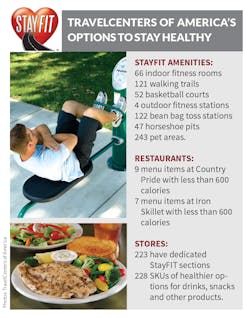Siphiwe Baleka was once a champion swimmer for Yale University, who just barely missed out on qualifying for the U.S. Olympic team. Being physically fit was always a part of his life. That was, however, until he became a truck driver. Within two months, he gained 15 lbs.—or 10% of his total body weight—and his eyes were opened.
Today, he runs Fitness Trucking and is among the most recognized health advocates within trucking, even being dubbed “the fitness guru of the trucking industry” by The Atlantic magazine. This success is only fueling Baleka’s anger. He believes far too many in trucking are failing to give drivers the education and tools they need to live a healthy lifestyle.
“There is incredible apathy in this industry” when it comes to the health crisis, Baleka said in an interview with Fleet Owner. “Fleets are under the delusion that by offering health screenings, they are really doing something.”
Leaning on his own experiences, he called it “criminally negligent” to send these “good men and women out into this unique environment” without proper consideration for their well-being.
“Imagine if NASA sent astronauts to outer space without educating them on the effect of zero gravity,” said Baleka, pointing to the difficulties of living without a kitchen and having schedules often dictated by freight availability.
“Drivers coming into this industry are sent out having no education or training on what is going to happen to their circadian rhythm or metabolism,” he continued.
Add in sleep deprivation and all the factors are in place that lead to weight gain and a greater likelihood of a lifetime of health problems.
There’s no shortage of data that back up Baleka’s suggestion drivers are in a health crisis. A study from the National Institute of Occupational Safety and Health found the prevalence of obesity among truck drivers is more than two times higher than the working population of the United States. Likewise, the percentage of cigarette smoking and self-reported diabetes by drivers were also at extremely elevated levels. A separate study by HireRight found one in five truckers left the industry, at least in part, because of health issues.
“Driving is a physically demanding profession, and getting proper rest, eating right and maintaining an exercise routine is a challenge due to the nature of the job,” said Steven Spencer, managing director of transportation and health care for HireRight.
EVOLVING TRUCK STOPS
Maintaining a healthy lifestyle on the road is tough, as any truck driver will tell you. However, truck stops are making changes to help ease the health burden on drivers. These days, customers are more likely to find a medical clinic, chiropractor, dentist, or pharmacy than in the past, said Tiffany Wlazlowski Neuman, vice president of public affairs at NATSO.
There are a growing number of exercise rooms, walking trails, bicycle paths, and even dog parks. Also, there are many more food choices for those seeking healthier alternatives.
“It’s no longer uncommon to find edamame or kale salads being sold alongside fresh fruits, yogurts, and granola, even in a smaller truck stop,” said Wlazlowski Neuman.
Additionally, there are “solid food choices like baked chicken, and salads are offered at many of the fast-food restaurant brands we partner with,” explained Tom Liutkus, senior vice president of marketing and public relations for TravelCenters of America.
The StayFit program offered at TA and Petro Stopping Centers represents healthier food options and workout facilities to help travelers stay fit while over the road. The StayFit website allows users to search for amenities at every location.
Liutkus said the salad bar remains “the No. 1 menu item selected by professional drivers” but acknowledged sales have leveled during the past two years.
Other menu items that are offered as part of the StayFIT program, like salmon and tilapia, have remained “remarkably steady” since being introduced, Liutkus said. The quality and assortment of healthier snacks are also increasing.
“This tells me that a certain percentage of drivers are watching what and how they eat,” he concluded.
Andrea Morley, lead nutritionist and health coach with Healthy Trucker, said she frequently pops into truck stops and has noticed a tell-tale sign that more truckers are watching what they eat. “I am seeing a lot more fresh fruits and vegetables widely available,” she said, whereas in the past she would find some rotting produce that had been sitting out too long.
Some fleets are trying to further assist by providing special deals for drivers who purchase healthier food options, Liutkus said. Drivers are also encouraged or incentivized to exercise. One way fleets accomplish this is by paying for UltraOne memberships through the StayFit program that gives access to indoor fitness rooms, walking trails, basketball courts, and other amenities.
Click here to view part 2: What else can be done to change the health environment?





